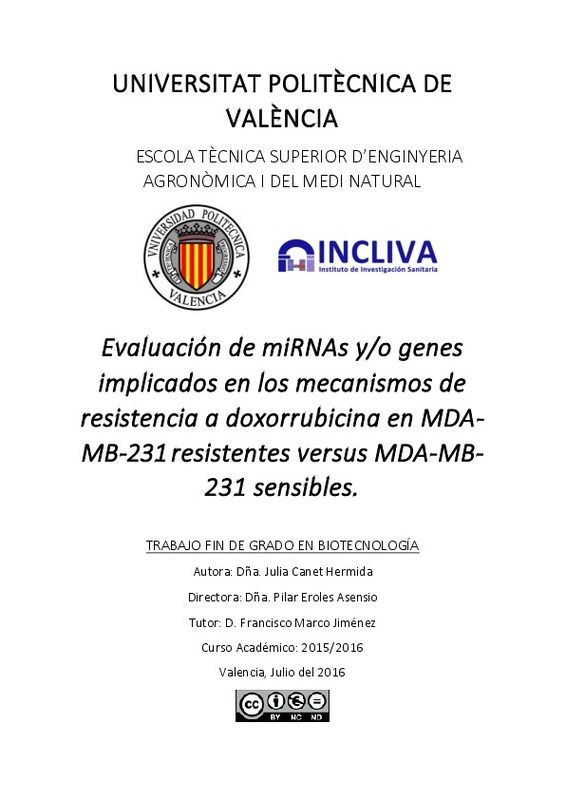|
Resumen:
|
[ES] El cáncer de mama es uno de los tumores más frecuentes entre las mujeres de todo el mundo.Avances recientes tanto en diagnóstico como en tratamiento están dando resultados prometedores con un aumento notable de la ...[+]
[ES] El cáncer de mama es uno de los tumores más frecuentes entre las mujeres de todo el mundo.Avances recientes tanto en diagnóstico como en tratamiento están dando resultados prometedores con un aumento notable de la supervivencia. Sin embargo, la recurrencia de esta enfermedad es un obstáculo para su curación. Actualmente entorno a un 40% de todos los pacientes con cáncer de mama recaen y entre ellos, un 60-70% sufren metástasis.
El cáncer de mama triple negativo es un tipo de cáncer muy agresivo, con alto grado de metástasis y un pobre pronóstico. Estudios anteriores han analizado los mecanismos de respuesta a los tratamientos actuales como la Doxorrubicina, a través del análisis de la expresión de genes y miRNAs en líneas celulares MDA-MB-231 y MDA-MB-468.
Basándonos en estos estudios, el siguiente Trabajo de fin de grado evaluará algunos de estos resultados a través de líneas celulares MDA-MB-231 resistentes a la Doxorrubicina generadas a partir de líneas sensibles. Para ello, se analizará la expresión diferencial de determinados miRNAs y/o genes entre líneas celulares sensibles y resistentes tratadas con Doxorrubicina con el objetivo de caracterizar y comprender los mecanismos de resistencia presentes en estos tipos celulares y su diferente comportamiento en cuanto a viabilidad, invasión y características cancerígenas se refiere.
[-]
[EN] Breast cancer is the most common cancer in women worldwide. Recent advances
in both diagnosis and treatment are giving results with a significant improvement in the survival
of patients. Nevertheless, cancer recurrence ...[+]
[EN] Breast cancer is the most common cancer in women worldwide. Recent advances
in both diagnosis and treatment are giving results with a significant improvement in the survival
of patients. Nevertheless, cancer recurrence is an obstacle to healing. Nowadays, around 40%
of patients with this disease relapse and amongst them 60-70% metastasize. Triple-negative
breast cancer is a very aggressive type with high rate of metastasis and low prognosis. At the
present time, this kind of cancer is treated only with chemotherapy. However, there are patients
who are treatment resistant.
The aim ofthis work was to analyse the miRNAs (hsa-miR-27a-5p, hsa-miR-27b-5p, hsa-miR-
29b-1-5p, hsa-miR-424-3p, hsa-miR-1972, hsa-miR-23a-5p, hsa-miR-1275) and the genes
(CDC25A, SIRT1, CCNE2, E2F1, CDK2, GMNN, BCL2, E2F3) as possible mechanisms implicated in
the resistance of the doxorubicine. In addition, miRNA hsa-miR-200c-3p expression was
evaluated as a possible modulator of CCNE2 and CDK2. To carry out these studies, the cells lines
MDA-MB-231 and in the same line with doxorubicin resistance were used. Both lines were
cultured with 5µM of doxorubicine during 24 hours. Finally, the expression profiles of the
miRNAs and genes were measured by RT-PCR.
The obtained results did not show a possible relationship between the miRNAs and doxorubicin
resistance. However a differential expression of the genes CDK2 and CCNE2 was observed
between resistant and sensitive cell lines. These results suggest the possible involvement of
these genes in the mechanism of resistance. Nevertheless, the analysis of the miRNA has-miR-
200c-3p did not show a regulation of CCNE2 and CDK2 by our cellular conditions performed.
[-]
|







